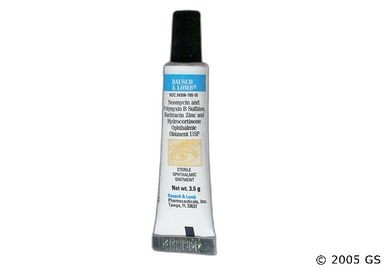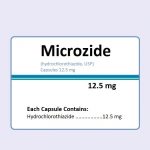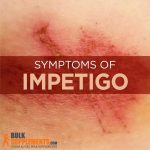
Contents
- 1 hydrocortisone/neomycin/polymyxin topical
- 1.0.1 Warnings
- 1.0.2 What are the side effects of hydrocortisone/neomycin/polymyxin topical?
- 1.0.3 What is the dosage for hydrocortisone/neomycin/polymyxin topical?
- 1.0.4 What drugs interact with hydrocortisone/neomycin/polymyxin topical?
- 1.0.5 Pregnancy and breastfeeding
- 1.0.6 What else should I know about hydrocortisone/neomycin/polymyxin topical?
- 1.0.7 Subscribe to MedicineNet’s Skin Care & Conditions Newsletter
- 1.0.8 Summary
hydrocortisone/neomycin/polymyxin topical
Hydrocortisone/neomycin/polymyxin topical is a combination product used to treat corticosteroid-responsive skin disorders (dermatoses) with secondary infection in adults. Hydrocortisone controls inflammation caused by dermatoses, while neomycin and polymyxin are antibiotics for the treatment of bacterial infections that occur secondary to skin defects and lesions caused by dermatoses.
Hydrocortisone is a potent anti-inflammatory drug that inhibits the release of inflammatory substances, constricts blood vessels, and reduces the migration of inflammatory cells to the inflammation site. Neomycin is a broad-spectrum antibiotic that kills both Gram-positive and Gram-negative bacteria. Neomycin prevents the synthesis of proteins that bacteria require to grow and survive. Polymyxin is a bactericidal drug that binds to fatty molecules on the outer cell membrane of Gram-negative bacteria, increases the permeability of the cell membrane, and causes bacterial death.
- Hydrocortisone: Hydrocortisone inhibits the release of inflammatory substances, constricts blood vessels, and reduces the migration of inflammatory cells.
- Neomycin: Neomycin kills bacteria by preventing protein synthesis and causing bacterial cell wall damage and death.
- Polymyxin: Polymyxin binds to the outer cell membrane of Gram-negative bacteria, increases cell membrane permeability, and causes bacterial death.
Polymyxin and neomycin together are active against:
- Staphylococcus aureus
- Escherichia coli
- Haemophilus influenzae
- Klebsiella-Enterobacter species
- Neisseria species
- Pseudomonas aeruginosa
Warnings
- Do not use hydrocortisone/neomycin/polymyxin topical in patients with hypersensitivity to any component of the formulation.
- Hydrocortisone/neomycin/polymyxin topical is for external use only. Do not apply in the eyes, or the external ear canal if the eardrum is perforated.
- Do not use hydrocortisone/neomycin/polymyxin topical on tuberculous or fungal skin lesions, or lesions from viral infections such as herpes simplex, varicella or vaccinia.
- Avoid prolonged use of hydrocortisone/neomycin/polymyxin topical over a wide area of skin, as it can increase systemic absorption and be toxic to the ears and kidneys.
- Take suitable precautions to minimize systemic absorption and monitor for signs and symptoms of hyperadrenocorticism if prolonged use is expected.
- Avoid use of hydrocortisone/neomycin/polymyxin topical in pediatric patients as systemic absorption can be higher in children than in adults.
- Treat superinfections appropriately if they occur due to prolonged antibiotic use.
- Monitor infected lesions because application of anti-inflammatory corticosteroids can promote spread of infections. Discontinue hydrocortisone and use appropriate antibacterial drugs if infection spreads.
- Topical steroids may be inadequate for generalized dermatological conditions which may require systemic steroid therapy.
IMAGES
What are the side effects of hydrocortisone/neomycin/polymyxin topical?
Common side effects of hydrocortisone/neomycin/polymyxin topical include:
- Rash
- Itching (pruritus)
- Redness (erythema)
- Skin sensitization
- Skin irritation
- Burning sensation
- Skin dryness (xerosis)
- Loss of pigmentation (hypopigmentation)
- Stretch marks (striae)
- Inflammation of hair follicles (folliculitis)
- Prickly heat (miliaria)
- Allergic contact dermatitis
- Skin maceration
- Acneiform eruptions
- Thinning of skin (skin atrophy)
- Excessive hair growth (hypertrichosis)
- Superinfection
- Skin inflammation around the mouth (perioral dermatitis)
- Severe allergy-like (anaphylactoid) reaction
- Ear and/or kidney toxicity with systemic absorption
Call your doctor immediately if you experience any of the following symptoms or serious side effects while using this drug:
- Serious heart symptoms include fast or pounding heartbeats, fluttering in your chest, shortness of breath, and sudden dizziness;
- Severe headache, confusion, slurred speech, severe weakness, vomiting, loss of coordination, feeling unsteady;
- Severe nervous system reaction with very stiff muscles, high fever, sweating, confusion, fast or uneven heartbeats, tremors, and feeling like you might pass out; or
- Serious eye symptoms include blurred vision, tunnel vision, eye pain or swelling, or seeing halos around lights.
This is not a complete list of all side effects or adverse reactions that may occur from the use of this drug. Call your doctor for medical advice about serious side effects or adverse reactions. You may also report side effects or health problems to the FDA at 1-800-FDA-1088.
What is the dosage for hydrocortisone/neomycin/polymyxin topical?
Topical cream
- (0.5%/3.5 mg/10,000 Units)/1 gram
Adult:
Steroid Responsive Dermatoses with Infection
- Apply thin layer of cream topically to affected area(s) BID-QID for up to 7 days
- Use sparingly
Pediatric:
- Safety and efficacy not established
Overdose
- Appropriate topical use of hydrocortisone/neomycin/polymyxin cream is unlikely to result in overdose.
- Excessive use of topical hydrocortisone products may result in systemic absorption and cause systemic side effects of corticosteroids.
- Excessive use of antibiotics such as neomycin and polymyxin can cause overgrowth of non-susceptible organisms and development of bacterial resistance.
- There is no information on oral overdose of topical hydrocortisone/neomycin/polymyxin. Overdose may be treated with symptomatic and supportive care.
What drugs interact with hydrocortisone/neomycin/polymyxin topical?
Inform your doctor of all medications you are currently taking, who can advise you on any possible drug interactions. Never begin taking, suddenly discontinue, or change the dosage of any medication without your doctor’s recommendation.
- Hydrocortisone/neomycin/polymyxin topical has no listed severe, serious, moderate, or mild interactions with other drugs.
The drug interactions listed above are not all of the possible interactions or adverse effects. For more information on drug interactions, visit the RxList Drug Interaction Checker.
Always tell your doctor, pharmacist, or health care provider of all medications you use, as well as the dosage for each, and keep a list of the information. Check with your doctor or health care provider if you have any questions about the medication.
Pregnancy and breastfeeding
- No adequate and well-controlled studies on the use of topical hydrocortisone/neomycin/polymyxin in pregnant women. Corticosteroid-containing products should be used during pregnancy only if benefits justify potential risks to the fetus.
- Hydrocortisone is excreted in breastmilk when orally administered. Nursing mothers should use hydrocortisone/neomycin/polymyxin topical with caution and avoid applying in the breast region.
What else should I know about hydrocortisone/neomycin/polymyxin topical?
- Use hydrocortisone/neomycin/polymyxin topical exactly as directed.
- Hydrocortisone/neomycin/polymyxin topical is for external use only. Avoid contact with eyes.
- If you experience persistent or worsening irritation, redness, swelling, or pain, discontinue the use of hydrocortisone/neomycin/polymyxin cream and report to your physician.
- Store hydrocortisone/neomycin/polymyxin topical safely out of reach of children.
- In case of oral ingestion and overdose, seek medical care or contact Poison Control.
Subscribe to MedicineNet’s Skin Care & Conditions Newsletter
By clicking "Submit," I agree to the MedicineNet Terms and Conditions and Privacy Policy. I also agree to receive emails from MedicineNet and I understand that I may opt out of MedicineNet subscriptions at any time.
Summary
Hydrocortisone/neomycin/polymyxin topical is a combination product used to treat corticosteroid-responsive skin disorders (dermatoses) with secondary infection in adults. Common side effects of hydrocortisone/neomycin/polymyxin topical include rash, itching, redness, skin sensitization, skin irritation, burning sensation, skin dryness, loss of pigmentation, stretch marks, inflammation of hair follicles, and others.


